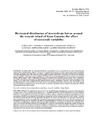Please use this identifier to cite or link to this item:
https://accedacris.ulpgc.es/jspui/handle/10553/2620
| Title: | Horizontal distribution of invertebrate larvae around the oceanic island of Gran Canaria: the effect of mesoscale variability | Other Titles: | Distribución horizontal de las larvas de invertebrados alrededor de la isla oceánica de Gran Canaria | Authors: | Landeira Sánchez, José María Barton, Eric D. Hernández-León, Santiago Hernández-León, Santiago |
UNESCO Clasification: | 251001 Oceanografía biológica | Keywords: | Generated Eddies Transport Fishes Region Area, et al |
Issue Date: | 2009 | Publisher: | Scientia marina. vol.73, nº 4, p. 761-771. ISSN 0214-8358. | Journal: | Scientia Marina | Abstract: | In October 1991, the horizontal distribution of invertebrate larvae was studied in the waters surrounding the\nisland of Gran Canaria (Canary Islands). The cruise was typified by the presence of three recurrent mesoscale hydrographic\nstructures: a cyclonic eddy southwest of the island, a warm lee region downstream of the island and the offshore boundary\nof an upwelling filament from the African coast reaching the southeast of the island. Decapod larvae were the most abundant\ngroup. In general, a rather high spatial variability was found. The horizontal distribution of the invertebrate larvae groups\nshowed that the highest values of abundance occurred in an elongated zone around the island oriented in the overall direction\nof flow, leeward and windward of the island, while the lowest values occurred off the eastern and western flanks of the\nislands. On the other hand, Stomatopoda and Mollusca larvae showed a distribution associated with the boundary of the\nupwelling filament and decapod larvae of pelagic species were distributed around the eddy structure. Our results suggest\nspecific retention mechanisms for the larvae of neritic invertebrate populations that are related to the particular physical\noceanography around Gran Canaria. Se estudió la distribución horizontal de las larvas de invertebrados\nalrededor de la isla de Gran Canaria (Islas Canarias) en octubre de 1991. La campaña se caracterizó por la presencia de tres\nfenómenos oceanográficos de mesoescala recurrentes: un remolino ciclónico al suroeste de la isla, la estela cálida a sotavento\nde la misma y el borde de un filamento proveniente del afloramiento africano situado al sureste de Gran Canaria. Las larvas\nde crustáceos decápodos fueron las más abundantes. En general, las larvas de los diferentes taxa estudiados mostraron una\ngran variabilidad en cuanto a su distribución espacial. La distribución horizontal de las larvas de los diferentes grupos de\ninvertebrados mostró que las densidades más altas se registraban alrededor de la isla en la banda cercana y orientada hacia\nel suroeste, en la dirección del flujo, mientras que los valores más bajos se encontraron en el norte y en los flancos este y\noeste de la isla. Por otro lado, las larvas de estomatópodos y moluscos presentaron una distribución asociada al frente del\nfilamento, mientras que las larvas de decápodos pelágicos se distribuyeron en torno al remolino ciclónico. Los resultados\nobtenidos sugieren la existencia de mecanismos de retención específicos para el mantenimiento de las poblaciones insulares,\nrelacionados con los procesos físicos de mesoescala predominantes | URI: | https://accedacris.ulpgc.es/handle/10553/2620 | ISSN: | 0214-8358 | DOI: | 10.3989/scimar.2009.73n4757 | Source: | Scientia Marina [ISSN 0214-8358], v. 73 (4), p. 761-771, (Diciembre 2009) |
| Appears in Collections: | Artículos |
SCOPUSTM
Citations
30
checked on Jun 8, 2025
WEB OF SCIENCETM
Citations
30
checked on Jun 8, 2025
Page view(s)
272
checked on Sep 6, 2025
Download(s)
172
checked on Sep 6, 2025
Google ScholarTM
Check
Altmetric
Share
Export metadata
This item is licensed under a Creative Commons License

